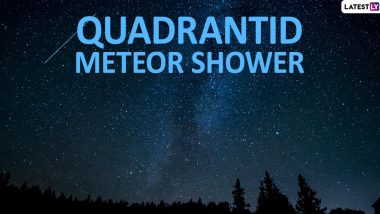The world everywhere is celebrating the end of one decade and beginning of the New Year 2020. While celebrations of the New year may still be ongoing in some parts of the world, 2020 brings in a great start for stargazers and astronomy lovers. The first major meteor showers of 2020, the Quadrantids will take place over the weekend. On January 3 and 4, people in North America can experience the view of the falling stars. Ahead of this spectacular event, we tell you a little more details about the date, timings and how you can watch it. Solar Eclipse December 2019 Pics and Videos: Netizens Share Glimpses of The Last Surya Grahan of The Year.
The end of 2019 also saw a nice end with some parts of the world seeing the annular solar eclipse, when the moon crossed its path from between the Earth and Sun. If you do not want to miss out on the next astronomical event, then keep yourselves free over the first weekend of 2020. NASA in Halloween Mode! Space Agency Releases Spooky Images of Creepy Bugs and Things Captured on Meteor Cameras (View Pics).
Quadrantid Meteor Shower 2020 Date and Time
The Quadrantids will be active from the night of January 3 to January 4. The showers will most likely peak on the night of January 3. The best time to watch these showers would be around and after 2 AM. As per the International Meteor Organization, it is likely to be active on January 4 at 08:00 UTC.
What is Quadrantid Meteor Shower?
This meteor shower gets its name from the constellation Quadrans Muralis (Mural Quadrant), created by the French astronomer Jerome Lalande in 1795. This constellation is located between the constellations of Bootes the Herdsman and Draco the Dragon. These meteors are said to originate from an asteroid named 2003 EH1, which is said to be an extinct comet.
Where and How to See Quadrantid Meteor Shower?
This meteor shower will be visible to those living in the Northern Hemisphere. It is said that more than 100 meteors are likely to pass through the night skies during the peak. If you want to see this shower then head to a place away from the city lights. A dark sky and surrounding make for a spectacular show of this phenomenon. If you cannot see it in your region, then there will be live streaming online from different observatories and astronomical channels.
So if you absolutely love observing the star, skies and astronomical events, then you should not miss the first meteor showers of 2020.
(The above story first appeared on LatestLY on Jan 01, 2020 04:09 PM IST. For more news and updates on politics, world, sports, entertainment and lifestyle, log on to our website latestly.com).













 Quickly
Quickly











